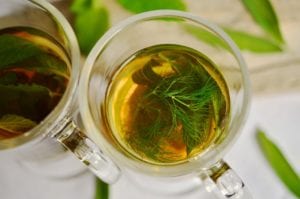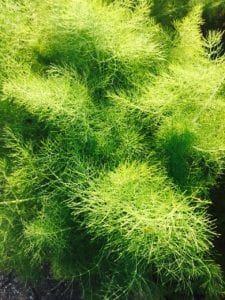Today is a celebration of two of our favorite butterfly-attracting herbs, fennel and dill. Fennel and dill are one of the reasons we like to advise planting some herbs for yourself to enjoy and some to offer the pollinators. Once the butterflies scout these out in your landscape, they are likely to head your way in droves.
Fennel and Dill
Fennel and dill look remarkably similar. They both have fine-textured, feathery leaves that are topped with umbels of tiny yellow flowers at maturity. However, a quick sniff or taste test will highlight one of their differences. Fennel emits a fresh anise aroma and has a sweet licorice taste while dill has the aroma and tangy taste of dill pickles (hence the name). The leaves, seeds, and oil of both herbs are used, but with fennel, you can also eat the bulbs.
When researching fun facts about using these herbs medicinally, I came across two that I find particularly entertaining. One is that dill is an ingredient in “gripe water” a product that is used to aid babies with indigestion. The second is that William Coles (botanist circa 1600s) wrote about fennel that it is “used much in drinks and broths for those that are grown fat, to abate their unwieldness and cause them to grow more gaunt and lank.” LOL! I guess that is another way of saying you can make a diet tea out of it. (Always consult your doctor before beginning a medicinal herb program for your health.)
Dill adds delicious flavor when pickling cucumbers for pickles, added to potatoes, or to brighten up potato and egg salads. Raw fennel thinly sliced adds a sweet crunch to salads. Braising or roasting fennel softens the anise flavor and makes a delicious side vegetable for seafood dishes. The entire plant of fennel is edible.


Both fennel and dill look great in the landscape with their fine-textured, feathery fronds, but my favorite similarity of these herbs is that they are excellent host plants for Swallowtail butterflies! These tiny white eggs that are laid atop and under the leaves of dill and fennel hatch in about 3-5 days. Swallowtail larvae emerge to happily munch the foliage. Again, this is why we say buy some for the pollinators and some for you. The abundance of yellow flowers these herbs both produce attract many other beneficial pollinators as well. We advise getting to know what larvae of butterfly and other beneficial insects look like so you don’t accidentally spray the good guys while trying to get rid of the bad guys.


Tips for Growing Dill and Fennel
Fennel is a perennial and dill is grown as an annual, but both will readily reseed. Fennel can reach heights of 4-6 ft. (possibly taller) while dill generally hits heights of about 2-3 ft. While both herbs are easily propagated by seed, it is generally recommended that you plant seeds of dill in spring and seeds of fennel in fall. However, they are both available as transplants in both spring and fall at Rainbow Gardens.
Dill is more of a cool weather herb; spring and fall are its best seasons. Once the heat rolls in, dill will go to seed and dies out. If its seeds are left to fall and go undisturbed, dill will pop up again when the weather begins to cool. Fennel will continue growing throughout the year, even surviving winters when they aren’t too severe. Cutting it back multiple times throughout the year helps keep the size of fennel in check.
Grow both herbs in sun to part sun. Do not grow them close together as they tend to cross pollinate, resulting in a poor taste. If you want to plant them in the same garden, make sure to have a few rows of other crops in between them, or plant in pots that you can keep separated. Soil should be rich in organic matter and most of all well-draining. Hold off on fertilizing plants until they are well established. If growing fennel for the bulb, cover the bulb with mulch or soil as it develops to keep it tender. (Tip: Florence fennel produces the largest bulbs.)


Dill and fennel are easy pollinator friendly plants to grow. Whether you choose to try one or both of these herbs, we think they will be a favorite in your landscape for years to come. Bring on the butterflies!
~The Happy Gardener, Lisa Mulroy


Fennel is a perennial and will come back every year bigger than before. It has drawn a lot of butterflies for sure. Thanks for the fine article.
Hi Richard,
Thank you so much for reading! Our fennel in our butterfly garden in Bandera is enormous right now from all our rain, and covered with tiny swallowtail cats! Glad you like yours as much as we like ours!
I find Bronze Fennel to be a nice visual alternative and my butterflies seem equally happy with it.
Hi Jerry!
I very much agree with your sentiment. I also find that when the first sun shines through them in the morning or the last bit of sun in the evening, they put off even more beauty! I haven’t found a fennel the butterflies don’t go crazy for!
I planted a four foot long row of dill and only saw two caterpillars in it. I brought the second one inside so nothing will eat it. It is growing nicely.
I found out fennel’s popularity quite by accident by planting it one fall. It was a light winter and took off next spring. Not only did I have swallowtail butterfly larva but also a neverending supply of lady bug larva as well. They enjoyed the aphids on the fennel. I love Mother Nature.
Hi Sharon,
I love Mother Nature too! Fennel always has a spot in my yard. Glad you are a fan too!
May I plant dill and fennel near one another if it’s only for consumption by butterfly larvae and not human consumption?
Absolutely you can. Dill is actually one of the few plants that can be planted with fennel and not be affected or inhibited by it. Even if you decide to consume it, it’s ok. But your butterfly caterpillars will love it.
I must have had 20 different swallowtail caterpillars on my Bronze Fennel this year.
Averaging 5-8 daily over 3 or 4 weeks. As they matured they either died or got eaten.
I finally pulled one out, put in a container, kept outside & still the last one died. I am suspecting a white growth on the plant that appears to be eating it? I saw it happen on the main plant to another…an insect gal?
Hi Robin,
I have forwarded your email to Laura Jarvis of The Butterfly Landing to see if she has some insight and help for you. You can also direct message her through facebook if you have an account, at The Butterfly Landing
Should the yellow flowers on dill be trimmed in the butterfly garden or left to go to seed?
Hmmmm… it depends on what you are using your dill for. If you are growing it for the pollinators, leave the flowers as they will be visited by pollinators searching for a sip of nectar. If you are growing it to use in the kitchen, pruning dill before it flowers will result in a bushier plant and more fronds (leaves) to use in your cooking. Prune just above a leaf set.